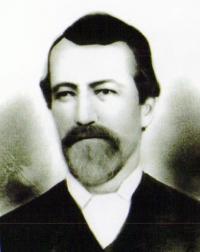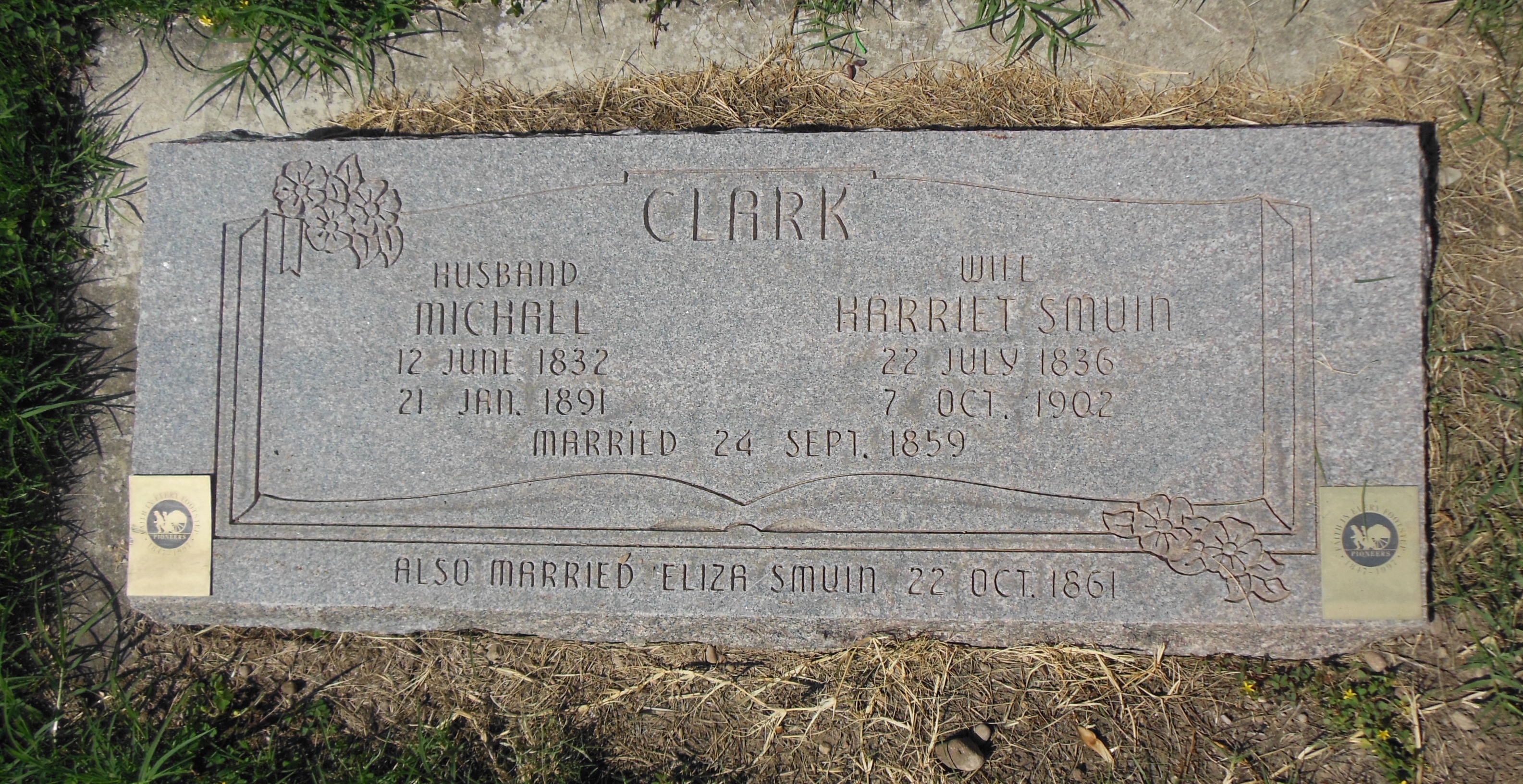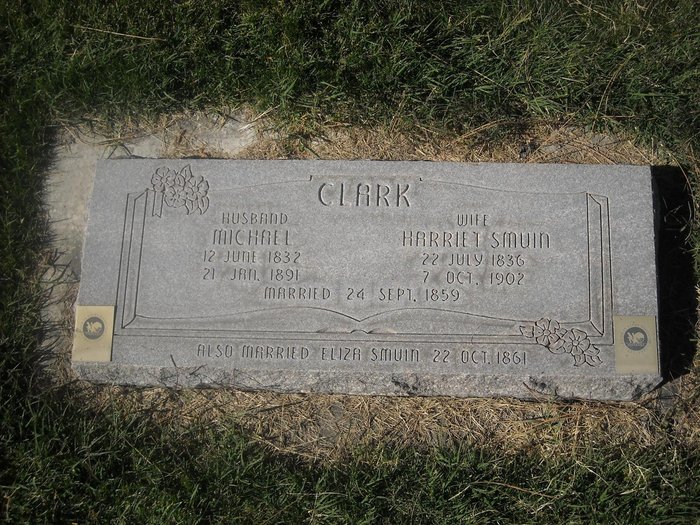Married Harriet Smuin, 24 Sep 1859, Salt Lake City, Salt Lake, Utah
Children - Edward Clark, Hannah Clark, Esther Hannah Clark, Jasper Clark, Sarah Ann Clark, Michael Clark, Elizabeth Clark
Married Eliza Smuin, 27 Oct 1861, Salt Lake City, Salt Lake, Utah
Children - Eldelbert Clark, Edward Clark, John Clark, Eliza Jane Clark, David Clark, Mary Ann Clark, Charles (Charley) Clark, William Thomas Clark, Alice Clark, George S. Clark Sophia Clark, Irintha Maria Clark, Sarah Lily Clark
Life Sketch of Michael Clark. Written by his daughter, Sarah Ann Clark Rudd, of Plymouth, Box Elder County, Utah.
Michael Clark was born June 12, 1832 at Chelmsford, Essex, England. He was the son of William Clark and Mary Sams. He married Harriet Smuin on September 24, 1859 at Salt Lake City, Utah. They had seven children: Sarah Ann, Jasper, Michael, Esther Hannah, Elizabeth, Hannah and Edward. The family made their home south of Kaysville, Utah. Michael Clark also married Eliza Smuin on October 28, 1861 at Salt Lake City, Utah. Their children: William Thomas, Sophia, David, (twins) Edelbert and Edmond, Eliza Jane, Irintha Maria, Alice, John, Mary Ann, Charles, Sarah Lily, and George. This family made their home south of Kaysville, Davis County, by Haight's Creek.
Michael Clark arrived in Salt Lake City the 16th of August 1859. He was a ward teacher, school trustee, farmer and stock raiser.*
The following is a sketch of the life of Michael Clark as told by his daughter, Sarah Ann Clark Rudd:
Michael Clark, my father, went to a tailor in London to have a suit made. That tailor was Aunt Harvery (Hannah Smuin Harvey). Harriet Smuin, my mother, was her help, and father got acquainted with her. Before any serious relations took place between them, Harriet sailed to America. Father soon after started to earn a way to come to America. He hired himself out to a family to work. After he had worked sometime the people he worked for decided to come to America. He came with them and earned his way over by his service, and then worked his way across the plains by being teamster for this family. It seems as if he didn't have any real hardship, or I feel it would have been mentioned sometimes. The paths across the plains had been broken by earlier travelers, it being about ten years since the first immigrants came.
It was the year of 1859, August 16th, that Father came to Salt Lake City, Utah. When the company arrived with Harriet Smuin he found her and soon made himself known and they were married one month later, September 24, 1859. They settled in Salt Lake City, living there about seven years. During the year of 1867 they moved to Kaysville, Davis County, Utah, on to a homestead. Father had married Eliza Smuin on October 28, 1861. At this time he had six children in the two families. My mother, Harriet, and her children lived in a room on the Ebenezer A. William farm located on the mountain road. Later we moved to a dugout in the hillside south of Haight's Creek. Many times the snow covered us completely and we had to be dug out. Later we moved to a shanty on the homestead.
Father then moved Auntie (Eliza Smuin Clark) and her children up from Salt Lake City to the homestead by Haight's Creek. He worked for a Mr. Bowen of North Farmington who owned a molasses mill. Father learned the trade and later purchased a mill for himself. He had some of the homestead land cleared so he could plant a little grain. He also planted sugar cane and started making molasses. I have heard the older people praise Father's molasses many times.
In the fall of the year at molasses making time, he made many children happy with his molasses candy which he made in a large iron kettle. He poured the molasses into barrels for keeping. Father made many a vat full of peach preserves and crab apple preserves for winter for the two families. In the spring we could go to the barrels and get the fruit which tasted like candied fruit, made only with molasses for sugar. We were blessed with plenty of eatable after Father got the land under cultivation. We did not have white bread, but a coarse bread.
At the time of the grasshoppers, Father had twenty acres planted in grain. It was early summer and the grain was pretty and green, promising a good crop. The grasshoppers came and before noon the ground was as bare as if the grain had been cut or dried up. Not a green spear was to be seen standing. That was the first year of the grasshoppers, and I think the worst. I remember Father saying to Mother, "Well, Harriet, our bread is gone." Mother answered saying, "The Lord will provide." For about four years we fought grasshoppers to save our crops and gardens so that we might have something to eat. We children went many times into the fields and helped drive them into the ditches of mud and water. Father has some large ear rings which he sold at this time for flour. With the efforts of the people and the Lord sending the seagulls, the crops were finally saved. Father had about nine children in both families to keep clothed and fed.
Father was a good worker; he provided the firewood for winter, gathering it from Bear's Canyon. He often took the children with him, having to care for them while Mother and Aunt Eliza took their straw hats to Salt Lake City to sell. However, on one of the trips we had an accident, hurting two of the smaller children, and from then on Father left us at home.
He helped work on the Salt Lake Temple a good deal during it's construction. Wages were not very high and Father traded his watch for flour.
Father was arrested on a polygamy charge, sent to prison, and then released on account of ill health. He hid for several months in various caves, or any place for shelter and food was taken to him by members of the family. He was tried, and freed to marry Eliza Smuin by the law of the land. A month later, after the trial, he died, January 21, 1891 at Kaysville, Davis County, Utah. He was buried in the cemetery at Salt Lake City, Utah.
*Pioneers and Prominent Men of Utah.
Married Harriet Smuin, 24 Sep 1859, Salt Lake City, Salt Lake, Utah
Children - Edward Clark, Hannah Clark, Esther Hannah Clark, Jasper Clark, Sarah Ann Clark, Michael Clark, Elizabeth Clark
Married Eliza Smuin, 27 Oct 1861, Salt Lake City, Salt Lake, Utah
Children - Eldelbert Clark, Edward Clark, John Clark, Eliza Jane Clark, David Clark, Mary Ann Clark, Charles (Charley) Clark, William Thomas Clark, Alice Clark, George S. Clark Sophia Clark, Irintha Maria Clark, Sarah Lily Clark
Life Sketch of Michael Clark. Written by his daughter, Sarah Ann Clark Rudd, of Plymouth, Box Elder County, Utah.
Michael Clark was born June 12, 1832 at Chelmsford, Essex, England. He was the son of William Clark and Mary Sams. He married Harriet Smuin on September 24, 1859 at Salt Lake City, Utah. They had seven children: Sarah Ann, Jasper, Michael, Esther Hannah, Elizabeth, Hannah and Edward. The family made their home south of Kaysville, Utah. Michael Clark also married Eliza Smuin on October 28, 1861 at Salt Lake City, Utah. Their children: William Thomas, Sophia, David, (twins) Edelbert and Edmond, Eliza Jane, Irintha Maria, Alice, John, Mary Ann, Charles, Sarah Lily, and George. This family made their home south of Kaysville, Davis County, by Haight's Creek.
Michael Clark arrived in Salt Lake City the 16th of August 1859. He was a ward teacher, school trustee, farmer and stock raiser.*
The following is a sketch of the life of Michael Clark as told by his daughter, Sarah Ann Clark Rudd:
Michael Clark, my father, went to a tailor in London to have a suit made. That tailor was Aunt Harvery (Hannah Smuin Harvey). Harriet Smuin, my mother, was her help, and father got acquainted with her. Before any serious relations took place between them, Harriet sailed to America. Father soon after started to earn a way to come to America. He hired himself out to a family to work. After he had worked sometime the people he worked for decided to come to America. He came with them and earned his way over by his service, and then worked his way across the plains by being teamster for this family. It seems as if he didn't have any real hardship, or I feel it would have been mentioned sometimes. The paths across the plains had been broken by earlier travelers, it being about ten years since the first immigrants came.
It was the year of 1859, August 16th, that Father came to Salt Lake City, Utah. When the company arrived with Harriet Smuin he found her and soon made himself known and they were married one month later, September 24, 1859. They settled in Salt Lake City, living there about seven years. During the year of 1867 they moved to Kaysville, Davis County, Utah, on to a homestead. Father had married Eliza Smuin on October 28, 1861. At this time he had six children in the two families. My mother, Harriet, and her children lived in a room on the Ebenezer A. William farm located on the mountain road. Later we moved to a dugout in the hillside south of Haight's Creek. Many times the snow covered us completely and we had to be dug out. Later we moved to a shanty on the homestead.
Father then moved Auntie (Eliza Smuin Clark) and her children up from Salt Lake City to the homestead by Haight's Creek. He worked for a Mr. Bowen of North Farmington who owned a molasses mill. Father learned the trade and later purchased a mill for himself. He had some of the homestead land cleared so he could plant a little grain. He also planted sugar cane and started making molasses. I have heard the older people praise Father's molasses many times.
In the fall of the year at molasses making time, he made many children happy with his molasses candy which he made in a large iron kettle. He poured the molasses into barrels for keeping. Father made many a vat full of peach preserves and crab apple preserves for winter for the two families. In the spring we could go to the barrels and get the fruit which tasted like candied fruit, made only with molasses for sugar. We were blessed with plenty of eatable after Father got the land under cultivation. We did not have white bread, but a coarse bread.
At the time of the grasshoppers, Father had twenty acres planted in grain. It was early summer and the grain was pretty and green, promising a good crop. The grasshoppers came and before noon the ground was as bare as if the grain had been cut or dried up. Not a green spear was to be seen standing. That was the first year of the grasshoppers, and I think the worst. I remember Father saying to Mother, "Well, Harriet, our bread is gone." Mother answered saying, "The Lord will provide." For about four years we fought grasshoppers to save our crops and gardens so that we might have something to eat. We children went many times into the fields and helped drive them into the ditches of mud and water. Father has some large ear rings which he sold at this time for flour. With the efforts of the people and the Lord sending the seagulls, the crops were finally saved. Father had about nine children in both families to keep clothed and fed.
Father was a good worker; he provided the firewood for winter, gathering it from Bear's Canyon. He often took the children with him, having to care for them while Mother and Aunt Eliza took their straw hats to Salt Lake City to sell. However, on one of the trips we had an accident, hurting two of the smaller children, and from then on Father left us at home.
He helped work on the Salt Lake Temple a good deal during it's construction. Wages were not very high and Father traded his watch for flour.
Father was arrested on a polygamy charge, sent to prison, and then released on account of ill health. He hid for several months in various caves, or any place for shelter and food was taken to him by members of the family. He was tried, and freed to marry Eliza Smuin by the law of the land. A month later, after the trial, he died, January 21, 1891 at Kaysville, Davis County, Utah. He was buried in the cemetery at Salt Lake City, Utah.
*Pioneers and Prominent Men of Utah.
Family Members
-
![]()
Sarah Ann Clark Rudd
1860–1942
-
![]()
William Thomas Clarke
1862–1926
-
![]()
Jasper Clark
1863–1864
-
![]()
Esther Hannah Clark Pattillo
1865–1957
-
![]()
Elizabeth Clark Trappett
1866–1949
-
![]()
Michael Clark
1867–1905
-
![]()
Adelbert Clark
1868–1868
-
![]()
Edmond Clark
1868–1868
-
![]()
Eliza Jane Clark Lott
1869–1941
-
![]()
Irintha Maria Clark Barber
1870–1940
-
![]()
Alice Clark
1872–1875
-
Hannah Clark Kirkland
1872–1896
-
![]()
Charles "Charley" Clark
1875–1887
-
![]()
Edward Clarke
1875–1945
-
![]()
Mary Ann Clark Barton
1876–1924
-
![]()
John Clark
1879–1880
-
Sarah Lilly Clark
1880–1886
-
![]()
George Smuin Clark
1884–1950
Advertisement
Advertisement
























